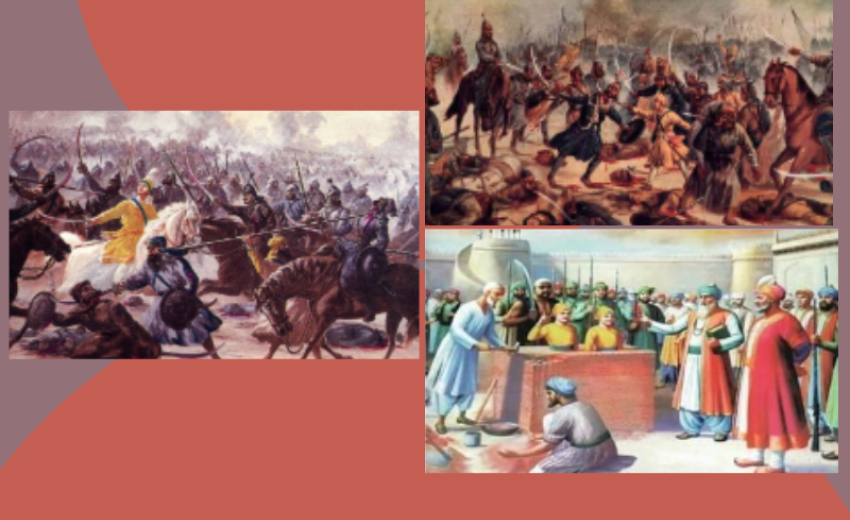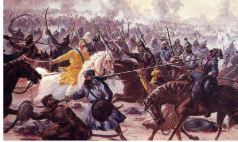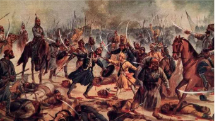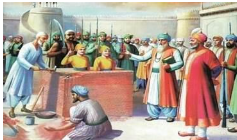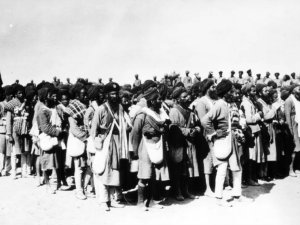The events of Saka Chamkaur Sahib and Saka Fatehgarh Sahib, significant chapters in Sikh history, exemplify courage, sacrifice, commitment to principles, and resilience. In 1705, at Chamkaur Sahib, Guru Gobind Singh Ji and his small band of warriors, including his sons, stood against a vast Mughal army, displaying extraordinary bravery. Similarly, in 1705 at Fatehgarh Sahib, Guru Gobind Singh Ji's younger sons, Baba Zorawar Singh Ji and Baba Fateh Singh Ji, were martyred for refusing to abandon their faith, embodying the ultimate sacrifice for freedom of thought and expression. These events offer profound lessons that resonate in the modern era, emphasizing the importance of ethical leadership, standing against oppression, and promoting social justice. The lessons from these sacrifices underscore the need for courage in adversity, unity, and selflessness and highlight the transformative power of youth. In today’s world, where societal challenges such as inequality, injustice, and conflict persist, the values demonstrated by these historical figures inspire individuals and communities to work toward a more equitable and harmonious society. By embracing these principles, modern society can cultivate resilience, empower future generations, and foster global peace and solidarity, ensuring the relevance of these sacrifices in shaping a better world.
Introduction
Saka Chamkaur Sahib and Saka Fatehgarh Sahib are two of the most poignant and significant moments in Sikh history, encapsulating the ideals of sacrifice, courage, and unyielding commitment to justice [1-4]. These events occurred in the early 18th century during the Mughal Empire’s persecution of Sikhs. Guru Gobind Singh Ji and his followers faced overwhelming odds to protect their faith and uphold righteousness [5-7]. At Chamkaur Sahib, Guru Gobind Singh Ji and his warriors, despite being vastly outnumbered, fought valiantly against a much larger Mughal army. At the same time, his two elder sons, Baba Ajit Singh Ji and Baba Jujhar Singh Ji, sacrificed their lives in the battle [8-9].
In a parallel display of extraordinary bravery, the younger sons of Guru Gobind Singh Ji, Baba Zorawar Singh Ji and Baba Fateh Singh Ji chose martyrdom at Fatehgarh Sahib, refusing to renounce their faith despite severe torture [10-11]. These sacrifices, though tragic, have become symbols of unwavering devotion to truth, justice, and religious freedom. The legacy of these martyrs continues to offer invaluable lessons in resilience, leadership, and selflessness. These lessons remain highly relevant in the modern era, offering guidance for addressing contemporary challenges such as injustice, oppression, and inequality.
Saka Chamkaur Sahib: A Saga of Supreme Sacrifice
Saka Chamkaur Sahib occurred in 1705, when Guru Gobind Singh Ji, the tenth Sikh Guru, and his small band of 40 warriors made a valiant stand against a massive Mughal army of several tens of
thousand soldiers at the mud fort of Chamkaur Sahib [8-9]. Guru Ji and his warriors displayed unparalleled bravery. Despite being vastly outnumbered, Guru Ji’s warriors fought fearlessly, sacrificing their
lives for the greater cause of protecting dharma and upholding justice. Among those who laid down their lives were Guru Ji’s two elder sons, Baba Ajit Singh Ji (18 years old) and Baba Jujhar Singh Ji (14 years old), whose bravery at such a young age is revered to this day.
Saka Fatehgarh Sahib: The Immortal Martyrdom of Sahibzadas
Saka Fatehgarh Sahib, occurring in December 1705, is another heart-wrenching episode in Sikh history. Guru Gobind Singh Ji's two younger sons, Baba Zorawar Singh Ji (9 years old) and Baba Fateh Singh Ji (7 years old), were captured by the Mughals and subjected to immense pressure to convert to Islam. Despite their tender ages, they refused to abandon their faith and accepted death over dishonour [10-11]. The Sahibzadas were bricked alive and ultimately martyred, showcasing extraordinary courage and commitment to their principles. Their grandmother, Mata Gujri Ji, also attained martyrdom in captivity, emphasizing the family’s unshakable faith and resilience.
Core Lessons from the Sacrifices
Both, Saka Chamkaur Sahib and Saka Fatehgarh Sahib demonstrate unwavering adherence to principles even in the face of death. Guru Gobind Singh Ji and his companions exemplified unity and collective resilience, proving that even a small, determined group can stand against overwhelming odds.
The sacrifices of the Guru's family illustrate that true strength lies in staying true to one's values, regardless of external pressures. The unparalleled bravery of Guru Gobind Singh Ji, his family, and the Sikh warriors serves as a timeless reminder that courage is not the absence of fear but the will to act righteously despite it.
These episodes also reflect the Sikh ethos of selflessness, where individual lives were willingly sacrificed to preserve justice, equality, and truth. The young Sahibzadas's exemplary courage highlights youth's potential as harbingers of change and leaders in challenging times.
Relevance in the Modern Era
The sacrifices at Chamkaur Sahib and Fatehgarh Sahib underscore the importance of ethical leadership. In a world increasingly driven by self-interest and corruption, the Guru's example of prioritizing collective well-being over personal gain offers a blueprint for responsible governance. The courage displayed in these sagas inspires individuals and societies to resist oppression and tyranny. Whether it is fighting for human rights, environmental justice, or freedom of speech, the spirit of resistance remains vital.
Injustice persists in various forms today, from systemic discrimination to exploitation. The sacrifices at Chamkaur Sahib and Fatehgarh Sahib inspire a commitment to justice, urging individuals to stand up against wrongdoings. The Sahibzadas’ martyrdom reminds us of the transformative potential of young minds. Encouraging the youth to embrace courage, integrity, and compassion can help build a just and equitable society.
In the face of global crises like pandemics, climate change, and socio-political unrest, the resilience displayed by Guru Gobind Singh Ji and his followers serves as a guiding light. Their ability to remain steadfast under extreme adversity teaches modern society the value of persistence and faith. Guru Gobind Singh Ji’s teachings and sacrifices transcend religious boundaries, emphasizing universal values such as equality, compassion, and respect for diversity. These principles are crucial in fostering harmony in today’s multicultural world.
Applications in Daily Life and Society
Drawing inspiration from these historical events, individuals and organizations can work toward eradicating social inequalities, promoting education, and ensuring the rights of marginalized communities. The stories of Saka Chamkaur Sahib and Saka Fatehgarh Sahib can be integrated into educational curricula to instill values of courage, sacrifice, and resilience in future generations.
The Guru’s family demonstrated unparalleled unity and mutual support. In an age where familial ties are often strained, their example encourages stronger relationships built on trust, love, and shared values. The sacrifices remind individuals of their responsibility toward society. Whether it is voting, volunteering, or advocating for social causes, every action contributes to a better world. The universal lessons of these sacrifices encourage global peace, urging nations and communities to resolve conflicts through dialogue and mutual respect rather than violence.
Inspiration for Personal Growth
The sacrifices at Chamkaur Sahib and Fatehgarh Sahib offer profound lessons for personal development. They teach individuals to (i) Develop a steadfast commitment to personal goals and ethical standards, even when faced with challenges. (ii) Overcome fear and uncertainty by taking bold steps toward self-improvement and societal contribution. (iii) Uphold integrity and values, even when it demands personal sacrifices. (iv) Work for the betterment of others, understanding that true fulfillment lies in serving humanity.
Conclusion
The sacrifices made during Saka Chamkaur Sahib and Saka Fatehgarh Sahib are not only pivotal moments in Sikh history but also timeless lessons that continue to resonate with profound relevance in the modern world. These events highlight the unparalleled courage, selflessness, and commitment to righteousness demonstrated by Guru Gobind Singh Ji, his family, and his followers. Their sacrifices show that pursuing justice, equality, and truth often requires immense personal cost, but such selflessness makes enduring change possible. The courage to stand against oppression, the willingness to sacrifice for the greater good, and the ability to remain steadfast in one’s values, even in the face of death, offer crucial guidance for individuals and societies today.
The principles of unity, resilience, and ethical leadership exemplified during these events provide potent lessons for addressing contemporary global issues such as injustice, inequality, and social division. We can overcome modern challenges by fostering a society rooted in these values and building a more just, compassionate, and harmonious world. The empowerment of youth, the promotion of social justice, and the need for global peace all find their foundation in the lessons derived from these sacrifices. As we continue to face personal, societal, and global adversities, the legacy of Saka Chamkaur Sahib and Saka Fatehgarh Sahib serves as a beacon of hope and inspiration, guiding us toward a future grounded in integrity, courage, and collective progress.
References
- S.G.P.C. Amritsar. (n.d.). Sri guru Gobind Singh Ji. Retrieved from https://sgpc.net/ten-guru-sahibs/guru-gobind-singh-sahib/
- Singh, Khushwant (2004), A History of the Sikhs: Volume 1: 1469-1838, 2nd edn. Oxford University Press; online edn, Oxford Academic, 18 Oct. 2012. https://doi.org/10.1093/acprof:oso/9780195673081.001.0001
- Grewal, J. S. (1991). The Sikhs of the Punjab. Cambridge: Cambridge University Press.
- Dahiya, A.S. (2015, March 18). Founder of the Khalsa: The Life and Times of Guru Gobind Singh. Hay House India. ISBN-13 978-9384544294
- Grewal, J. S. (2020, June 20). Guru Gobind Singh (1666-1708).: Master of the White Hawk. Oxford University Press. ISBN-13 978-0199494941
- Singh, D.P. (2017, Jan.- Dec.). Guru Gobind Singh Ji - His Mission and Vision. Understanding Sikhism. Montreal, QC. Canada. 19(1). 21-26.
- Kaur, H. (2018, July 19). A history of Sacrifice, Remembrance, and Courage. State of Formation. Retrieved from https://stateofformation.org/2018/07/a-history-of-sacrifice-remembrance-and-courage/
- Singh, B., & Singh, B. (2024, December 23). The Battle of Chamkaur sahib: Martyrdom week – An unparallel chapter in Sikh history. Retrieved from https://www.eurasiareview.com/24122024-the-battle-of-chamkaur-sahib-martyrdom-week-an-unparallel-chapter-in-sikh-history-oped/#google_vignette
- Singh, G. (2015, Dec. 29). At the battle of Chamkaur. SikhNet. https://www.sikhnet.com/news/battle-chamkaur
- Gill, T., Sidhu, D. S., (2021). Sahibzade Zorawar Singh & Fateh Singh: The Valiant Sons of Guru Gobind Singh. Ist Edition. Singh Brothers. Amritsar. India. ISBN: 978-93-82887-78-2
- Kaur, L. (2016, Dec. 28). The Untold Story of Mata Gujri Kaur & the Shoteh Sahibzadeh. Kaur Life. https://kaurlife.org/2016/12/28/untold-story-mata-gujri-kaur-shoteh-sahi...
*******
